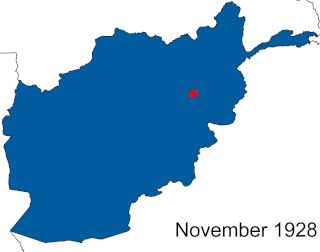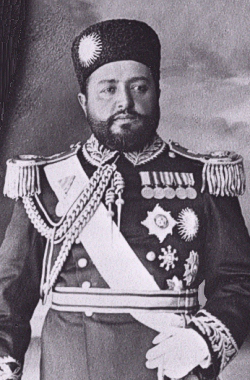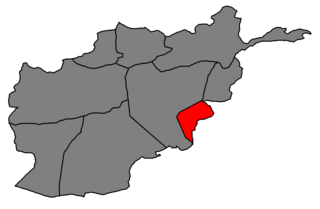
The Afghan Civil War was fought from 14 November 1928 to 13 October 1929. Rebelling, and subsequently governing Saqqawist (Saqāwīhā) forces under Habibullāh Kalakāni fought against various opposing tribes and rival monarchs in the Kingdom of Afghanistan, among whom Mohammed Nādir Khān eventually achieved a preponderant role. Despite early successes, such as the capture of Kabul and defeat of Amanullah Khan on 17 January 1929 or the capture of Kandahar on 3 June, the Saqqawists were eventually deposed by anti-Saqqawist forces led by Nadir on 13 October 1929, leading to Nadir's ascension as King of Afghanistan, who ruled until his assassination on 3 November 1933.

Habibullah Khan was the Emir of Afghanistan from 1901 until his assassination in 1919. He was the eldest son of the Emir Abdur Rahman Khan, whom he succeeded by right of primogeniture in October 1901. His grandfather was Mohammad Afzal Khan.

Habibullah Kalakani, derogatively called "Bacha-ye Saqao", was the ruler of Afghanistan from 17 January to 13 October 1929, as well as a leader of the Saqqawists. During the Afghan Civil War (1928–1929), he captured vast swathes of Afghanistan and ruled Kabul during what is known in Afghan historiography as the "Saqqawist period". He was an ethnic Tajik. No country recognized Kalakani as ruler of Afghanistan.
The following lists events that happened during 1913 in Afghanistan.
The following lists events that happened during 1924 in Afghanistan.
The following lists events that happened during 1930 in Afghanistan.
The following lists events that happened during 1929 in Afghanistan. The Afghan Civil War continued from the previous year.

The Mangal are a tribe of the Pashtun people residing in eastern Paktia and adjacent Khost provinces of Afghanistan, and in the town of Tari Mangal, district Kurram, Pirdil Khel, Fatima Khel and Surrani of Bannu Pakistan. Their land constitutes the northeastern part of the Loya Paktia region. The Mangals descend from Karlani Pashtun lineage.

Mohammad Nadir Shah was King of Afghanistan from 15 October 1929 until his assassination in November 1933. He became the king after his victory in the Afghan Civil War of 1928–29. Previously, he served as Minister of War, Afghan Ambassador to France, and as a general in the Royal Afghan Army. He and his son Mohammad Zahir Shah, who succeeded him, are part of the Musahiban.

The Khost rebellion, also known as the 1924 Mangal uprising, the Khost revolt or the Mangal Revolt was an uprising against the Westernization and modernizing reforms of Afghanistan’s king, Amanullah Khan. The uprising was launched in Southern Province, Afghanistan, and lasted from March 1924 to January 1925. It was fought by the Mangal Pashtun tribe, later joined by the Sulaiman Khel, Ali Khel, Jaji, Jadran and Ahmadzai tribes. After causing the death of over 14,000 Afghans, the revolt was finally quelled in January 1925.

Bārakzai is the name of a Pashtun tribe from present-day Kandahar, Afghanistan. '"Barakzai" is a common name among the Pashtuns and it means "son of Barak" in Pashto. According to the Encyclopædia Iranica, "In the detailed Pashtun genealogies there are no fewer than seven instances of the ethnic name Bārakzī, at very different levels of tribal segmentation. Six of them designate simple lineages within six different tribes located in the Solaymān mountains or adjacent lands... The seventh instance, on the other hand, designates one of the most important Pashtun tribes in numbers and historic role, part of the Zīrak branch of the Dorrānay confederation.

Bilateral relations of Afghanistan and the United Kingdom of Great Britain and Northern Ireland span a long and eventful history, dating back to the United Kingdom's Company rule in India, the British-Russian rivalry in Central Asia, and the border between modern Afghanistan and British India. There has been an Afghan embassy in London since 1922 though there was no accredited Afghan ambassador from 1981 to 2001.

Amir Ali Ahmad Khan, Shaghasi was an Afghan king from the Shaghasi family of the Barakzai tribe who was declared king of Afghanistan twice in 1929. He was first declared amir of Afghanistan by an influential cleric, Naqib Sahib on 20 January 1929, in eastern Afghanistan, but was defeated by Kalakani at Jagdalak on 19 February 1929. He was also declared as the amir of Afghanistan for the second time on 23 June 1929 in Kandahar, Afghanistan, by another highly influential Mufti Abd. Wasi Kandahari, but was defeated and captured by Kalakani on 3 July 1929.
The Khost rebellion was an anti-taxation revolt that began in early 1856 in the Emirate of Afghanistan. After encountering minor resistance in February 1856, the rebelling Khostwal and Waziri tribesmen besieged the Khost Fort in March. Despite failed peace negotiations in July and August, the rebellion did not end until early 1857.
Abd-al Karim (1897–1927) was an Afghan emir who ruled only in the Southern Province from July 1924 to January 1925.
Jehandad Khan was an Afghan rebel emir who ruled only in Khost. He was born as a member of the Ghilzai tribe, and spent most of his life as a chieftain. After start of the Khost rebellion on 2 May 1912, he briefly laid claim to the Afghan throne in opposition to Habibullah Khan, but an offensive by Muhammad Nadir Khan forced him to flee to the British Raj by the end of the same month. When Jehandad arrived in India, he was given the option of immediately returning to Afghanistan or staying in India, and he chose the latter. He then appealed to the British authorities for an intervention in Afghanistan to aid the rebellion, but was unsuccessful. Later in 1912, Jehandad managed to return to Afghanistan, where he was apprehended, put on trial, sentenced to death and finally executed by a firing squad in 1914.

The Afghan tribal revolts of 1944–1947 or the Khost disturbances were a series of tribal revolts in the Kingdom of Afghanistan by Zadran, Safi and Mangal tribesmen which lasted from February 1944 to January 1947. The causes of the revolts lay in the worsening conditions of farmers, changes in conscription laws, the elimination of the power of Safi tribal leaders, Amanullah loyalism, trading monopolies, government surveillance, taxation, and poverty. The conflict began when government forces clashed with the forces of a tribal leader named Mazrak, who led the Zadran tribe in revolt. The Zadran uprising was followed by additional uprisings by the Safi and Mangal, the former of which elected their own king, Salemai. Faqir of Ipi, a tribal leader from Waziristan, also fought for the restoration of former king Amanullah Khan alongside other rebels.

Amanullah loyalism was a series of early 20th century movements in the Kingdom of Afghanistan to restore Amanullah Khan as king of Afghanistan after he was deposed in January 1929 during the Afghan Civil War. Loyalists were sometimes referred to as Amanite. Loyalists tried to achieve this in various ways, including armed rebellions, political parties, colluding with foreign powers and assassinations. These movements petered out by the late 1940s. Amanullah died in exile in 1960 in Zürich, Switzerland, without ever regaining control, except a brief period of control in southern Afghanistan in the 1929 Afghan Civil War.

Babrak Khan was a Zadran chieftain who was the father of Said Akbar Babrak and of Mazrak Zadran.

Abdur Rahim Khan was an Afghan governor of Herat. He was born in 1886 in Kohistan. He served as the commander of Habibullah Khan's bodyguard from age 16. In 1921 he was promoted to brigadier. During the Afghan Civil War of 1928-1929 he joined the Saqqawists and was sent to Mazar-i-Sharif to organize a revolution. In September 1932 he was appointed by Mohammed Nadir Shah as governor of Herat. Also in 1932, he prevented a mutiny in Herat. He was appointed head of Perso-Afghan Boundary Commission in September 1934. He was appointed First Deputy Prime Minister in 1938, and then as Second Deputy Prime Minister in 1940. In January 1946, he was arrested for suspected complicity with the Safi during the Afghan tribal revolts of 1944–1947, together with his son-in-law Khalilullah Khalili. He was released in 1948.












